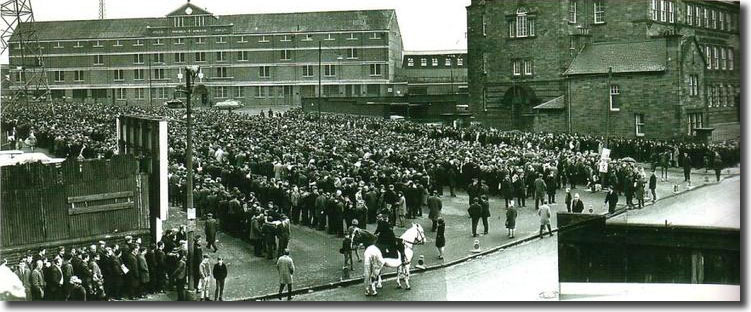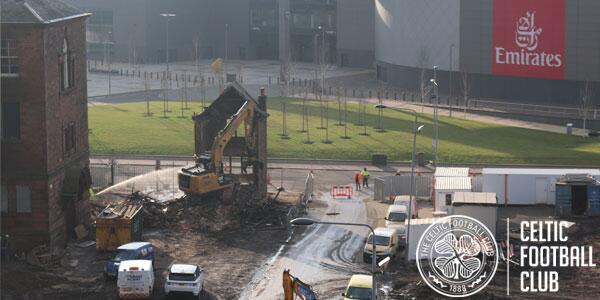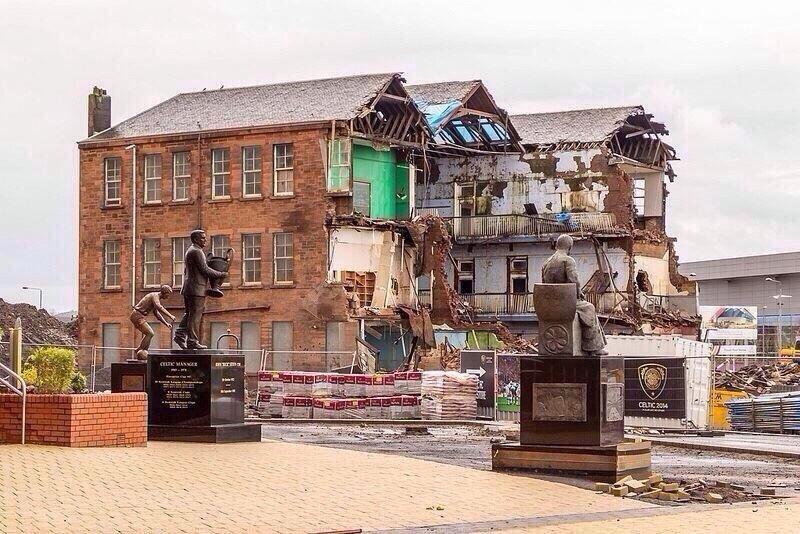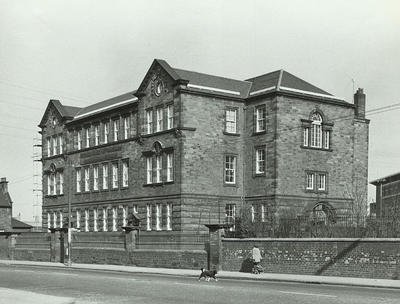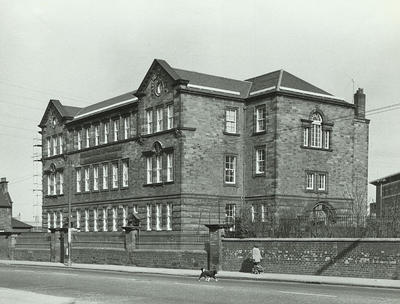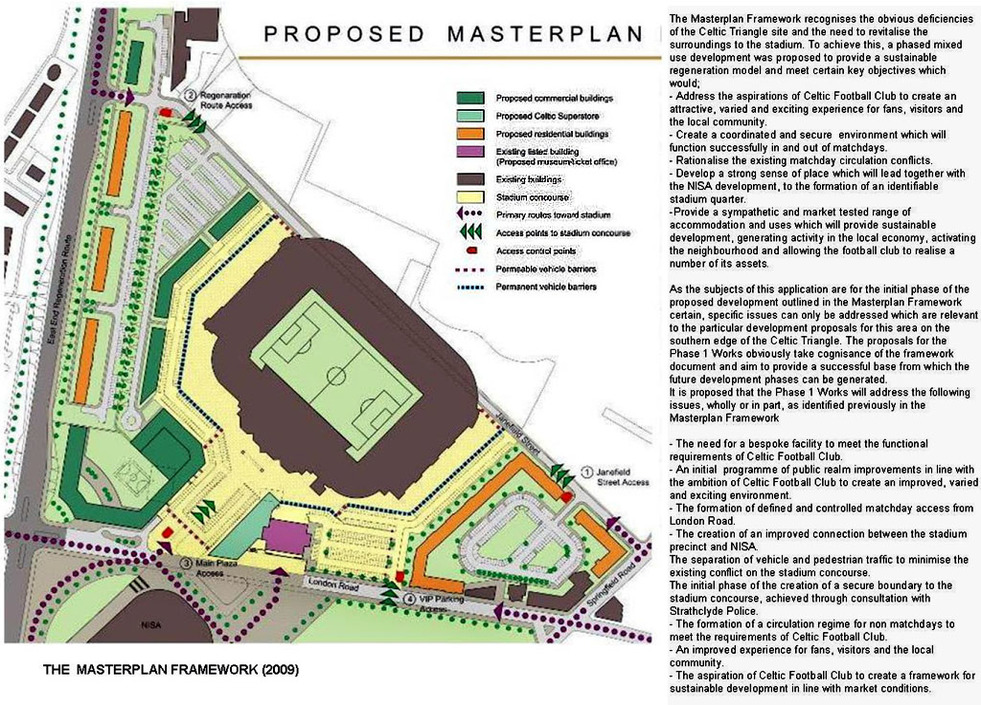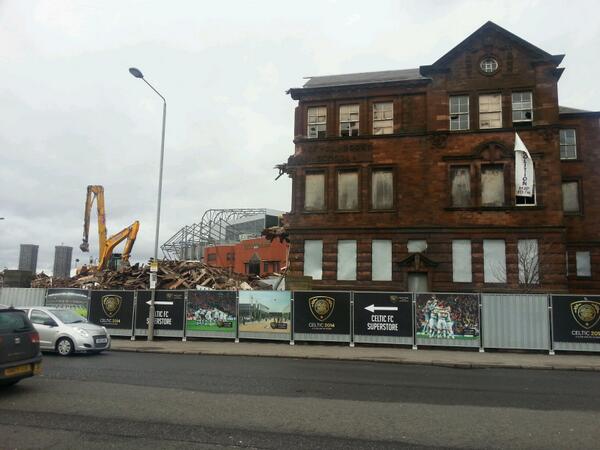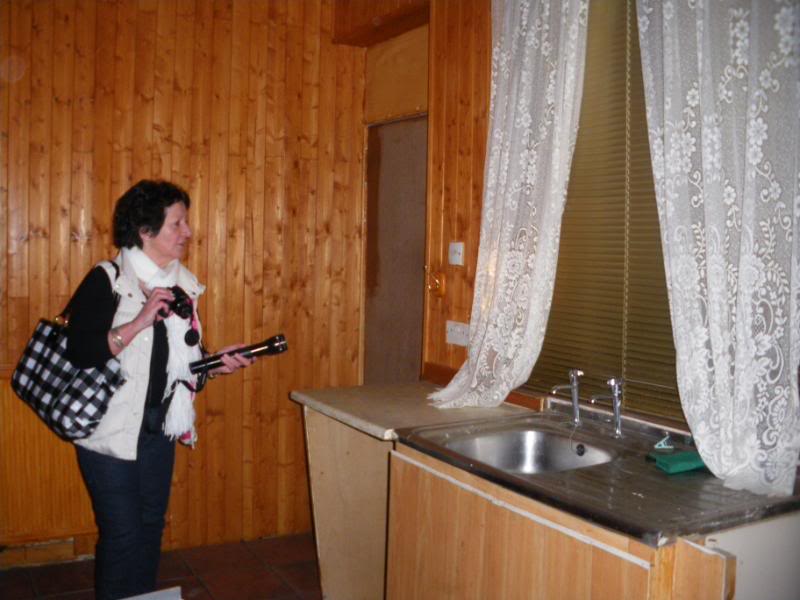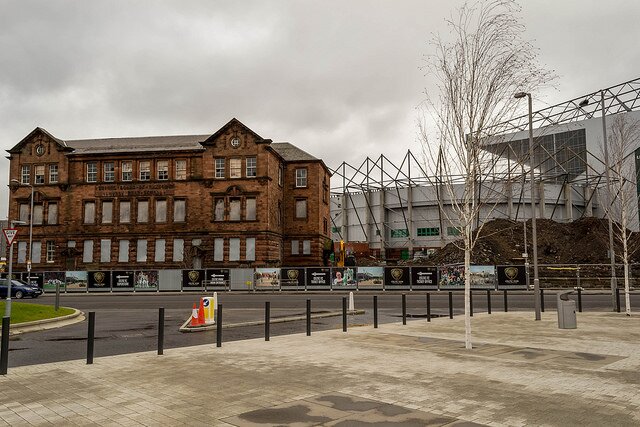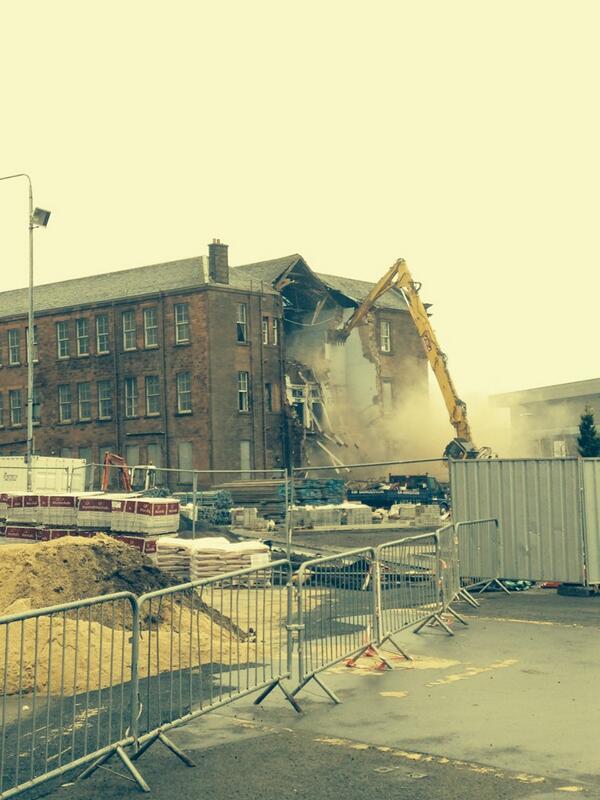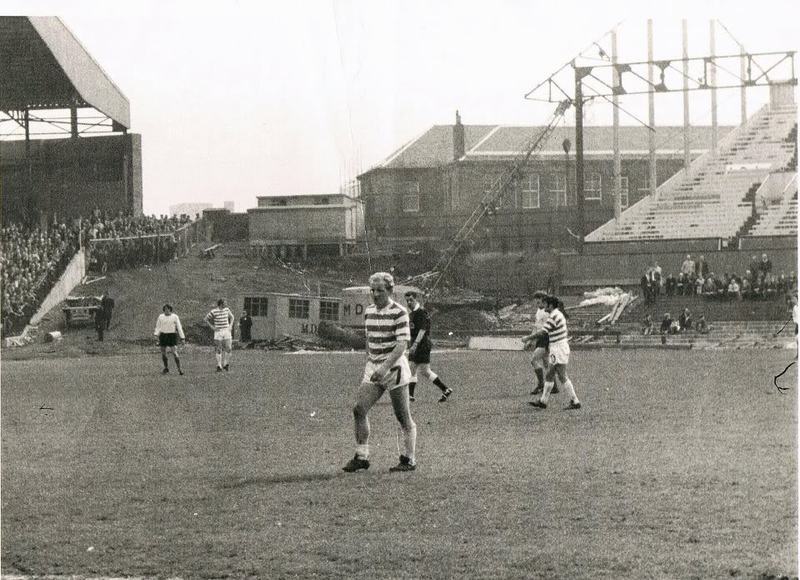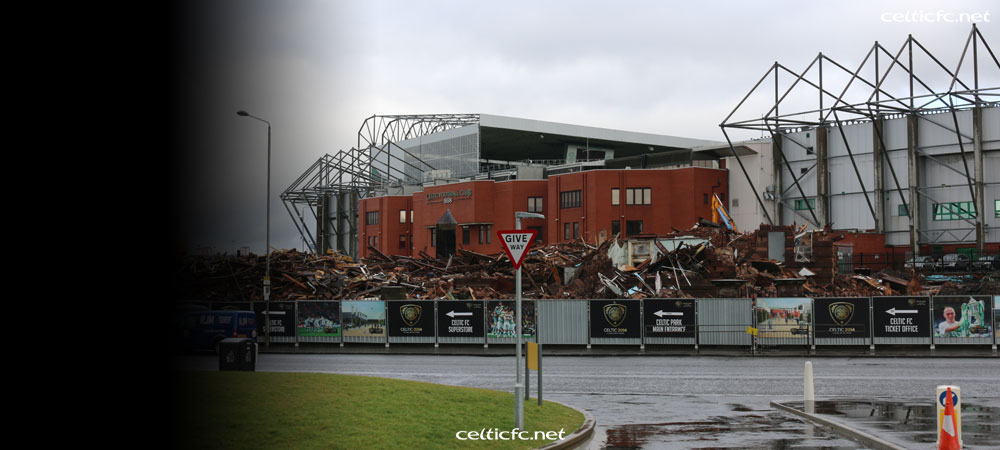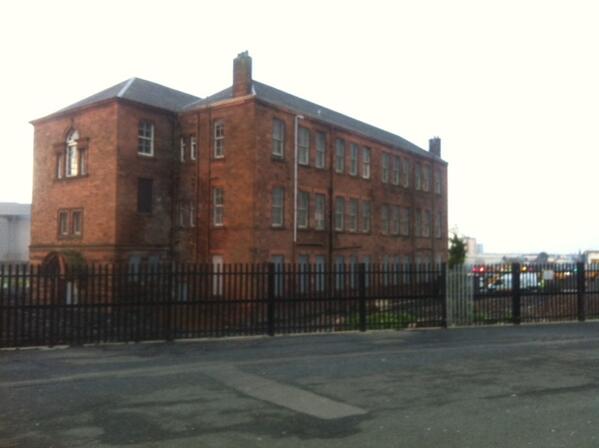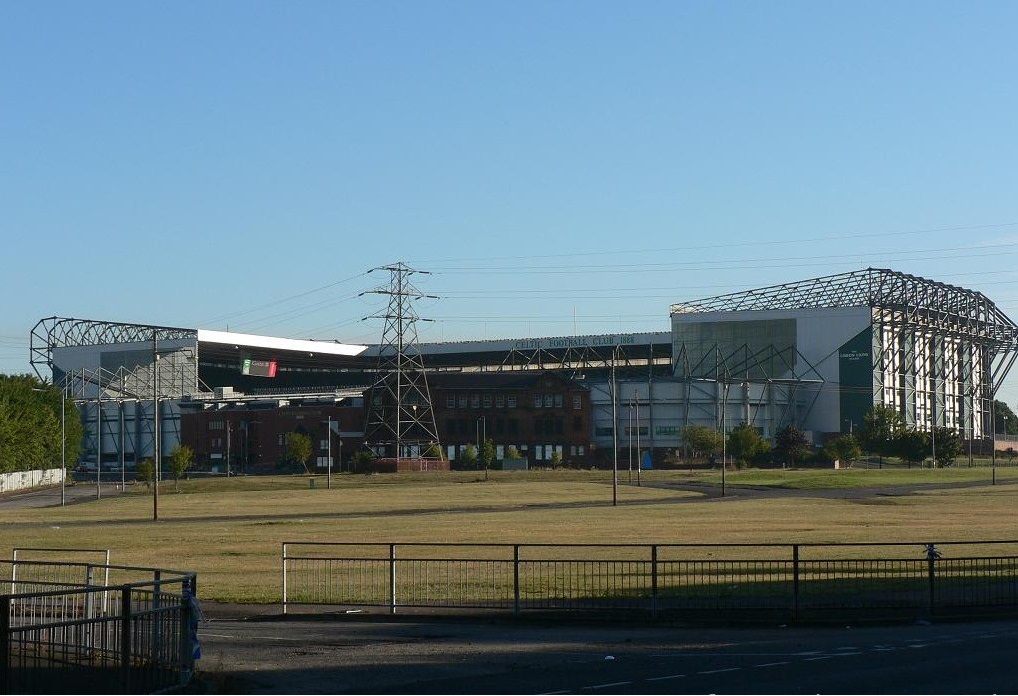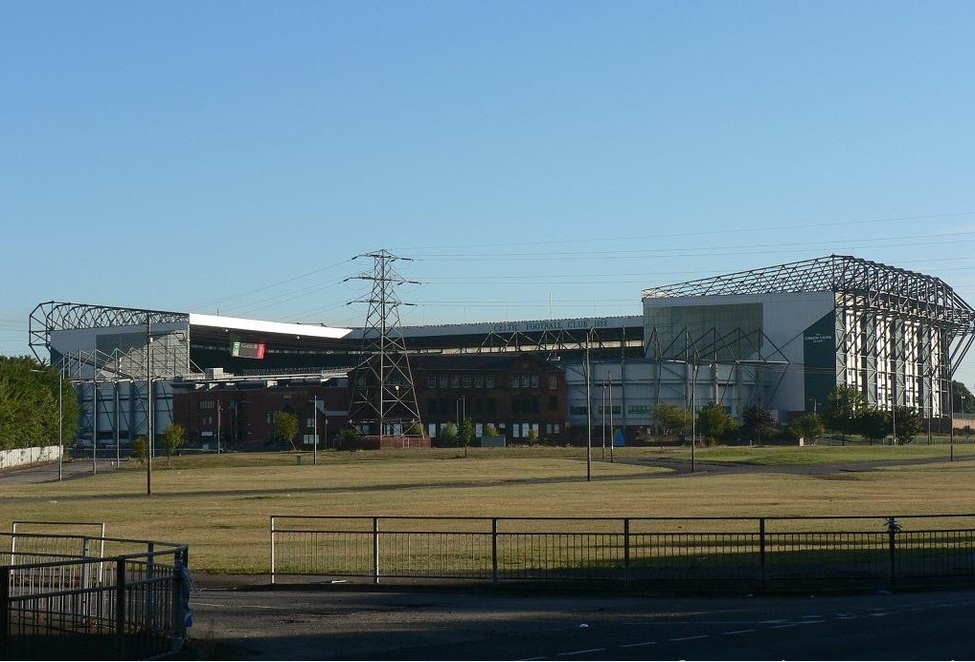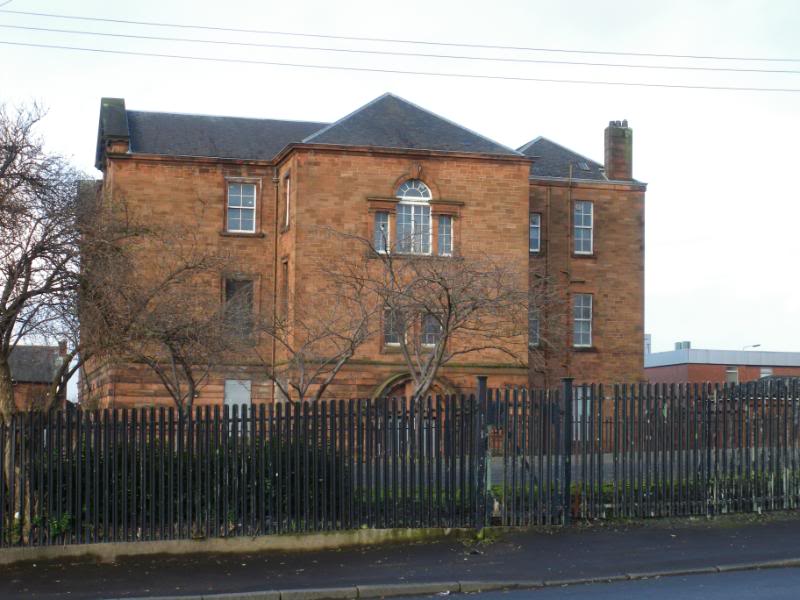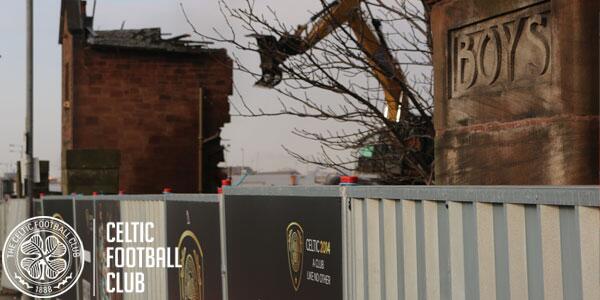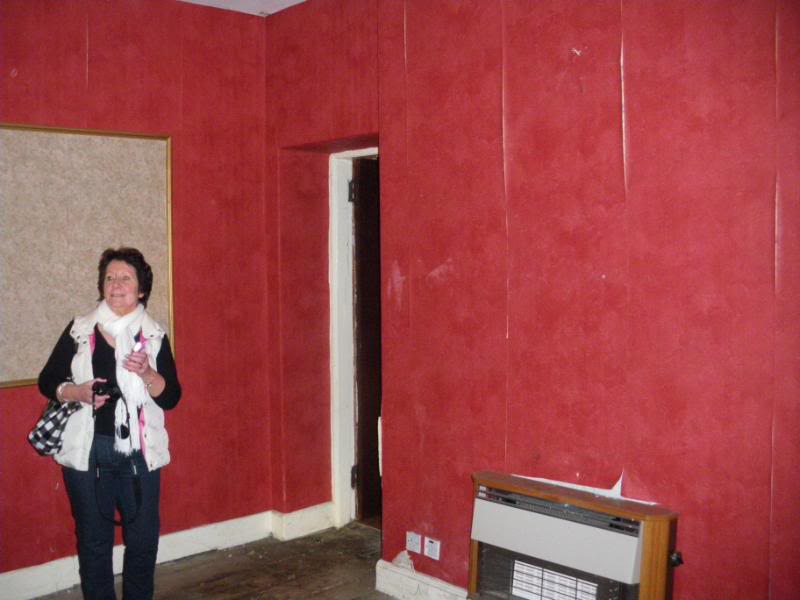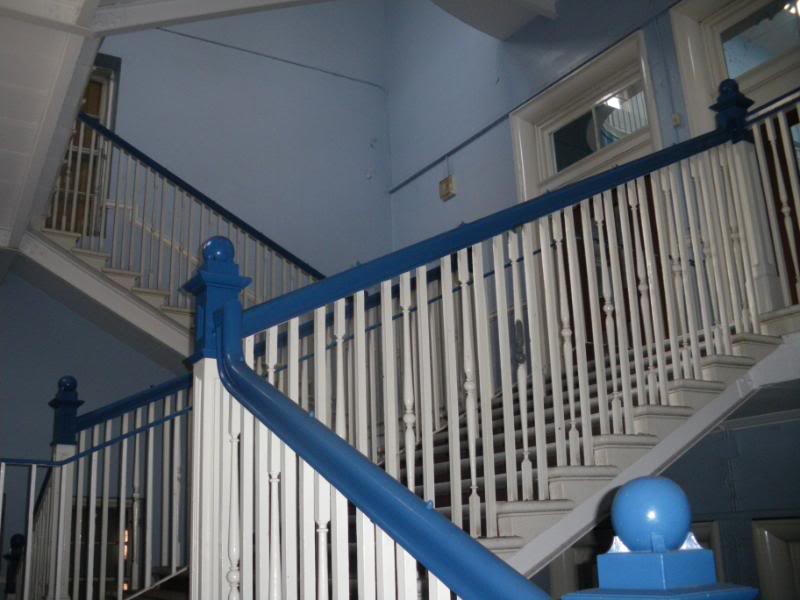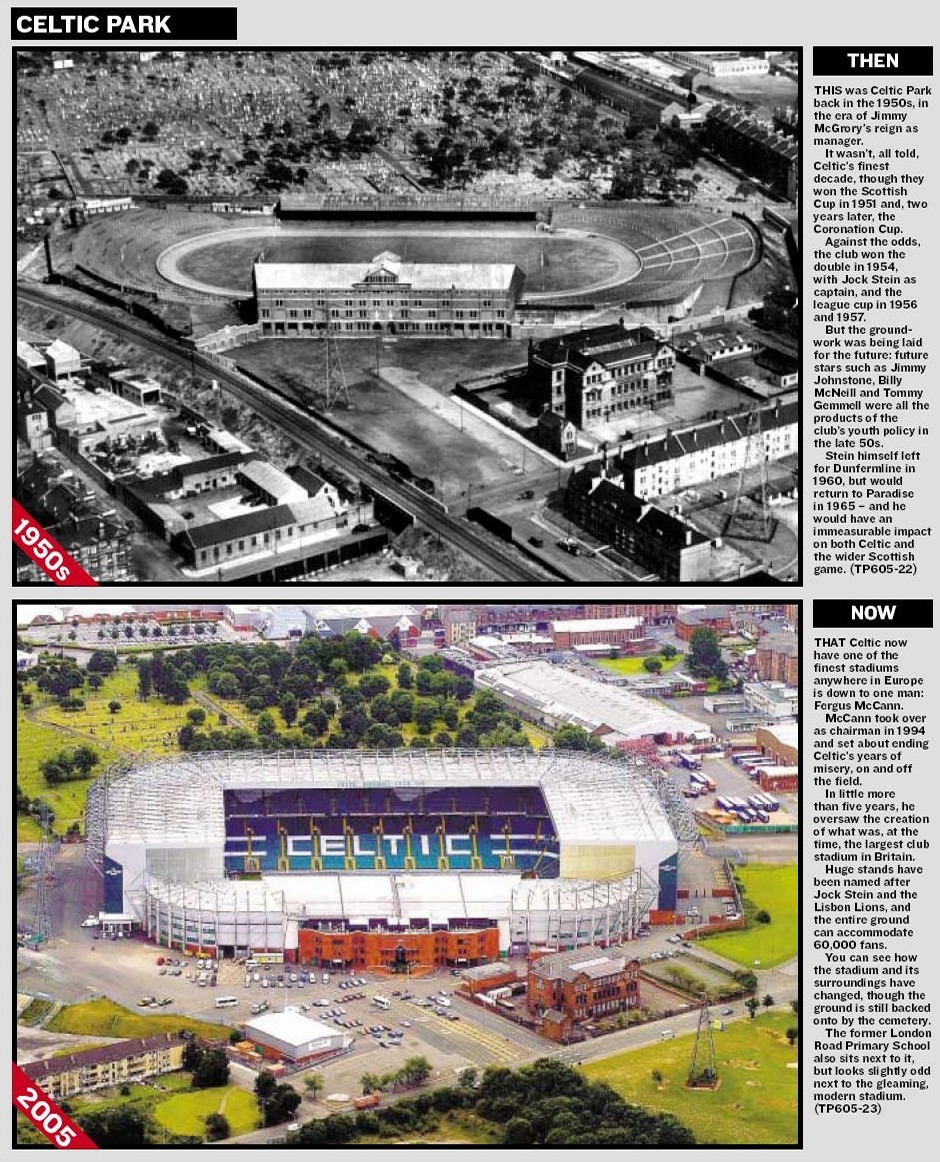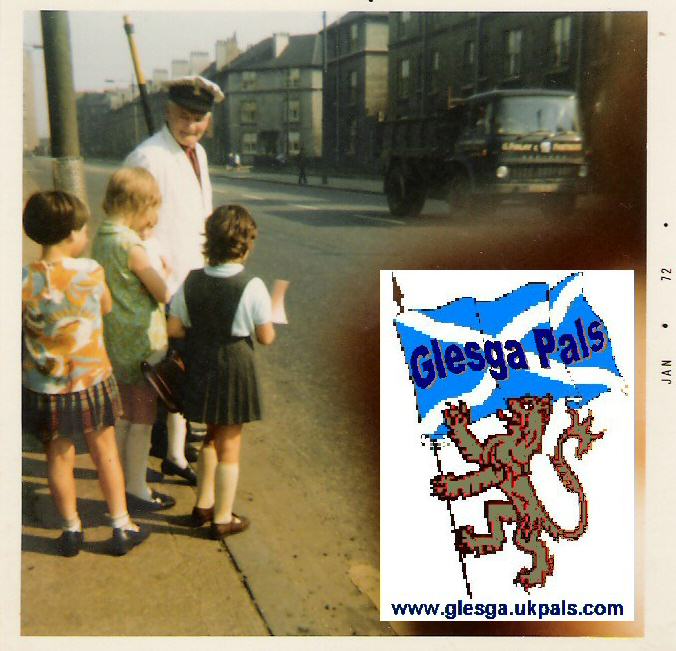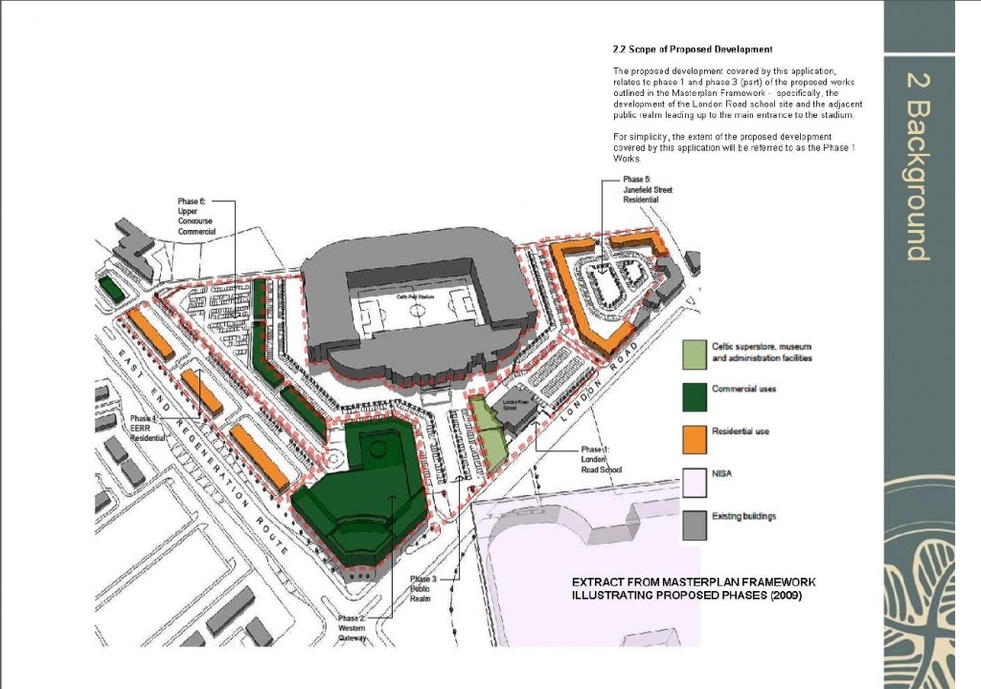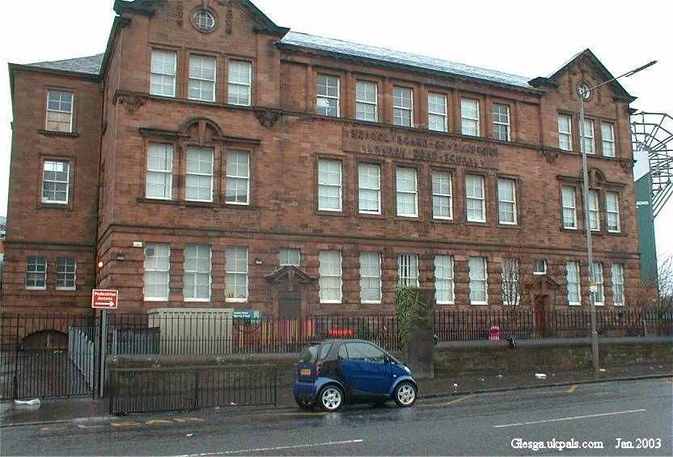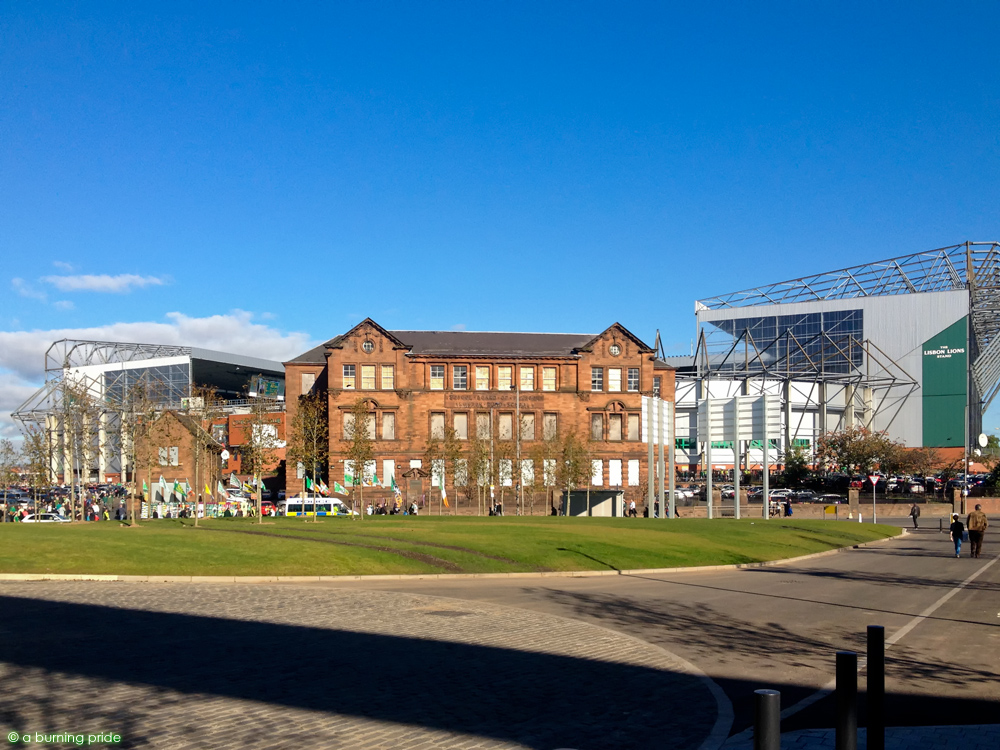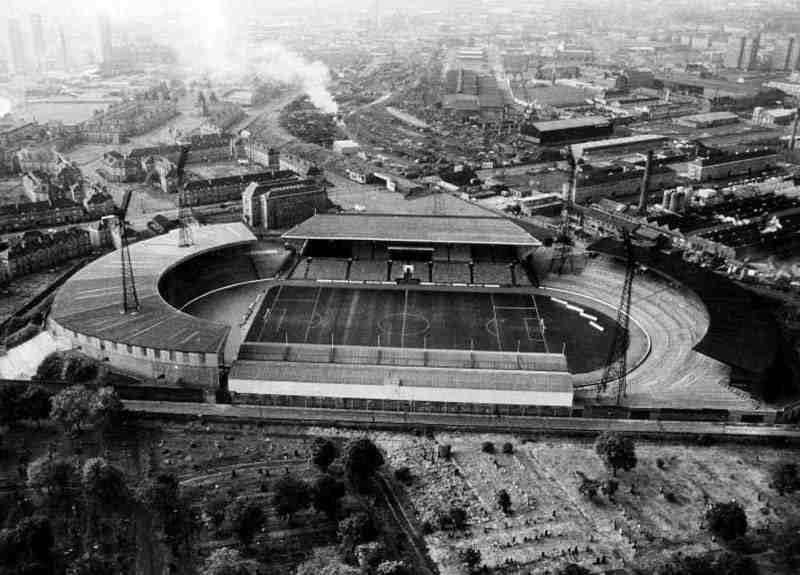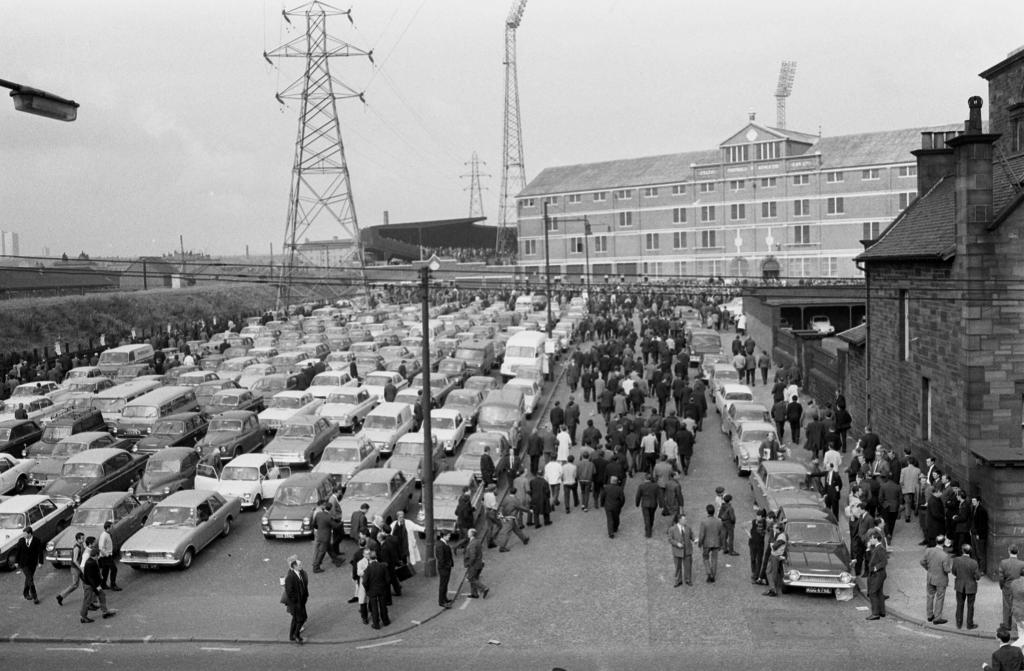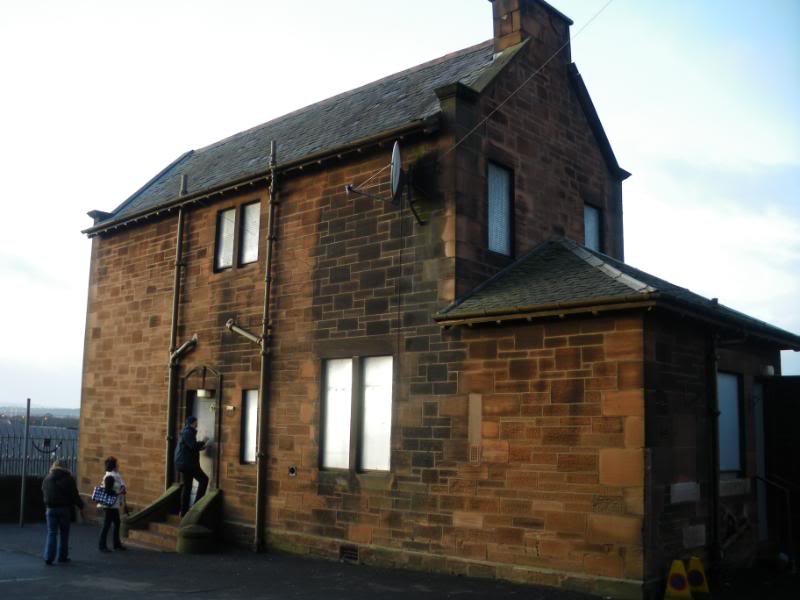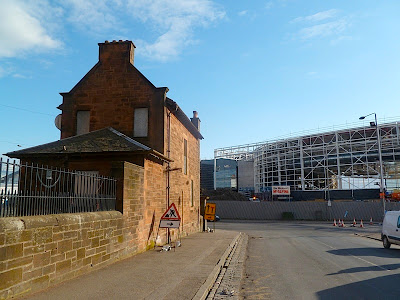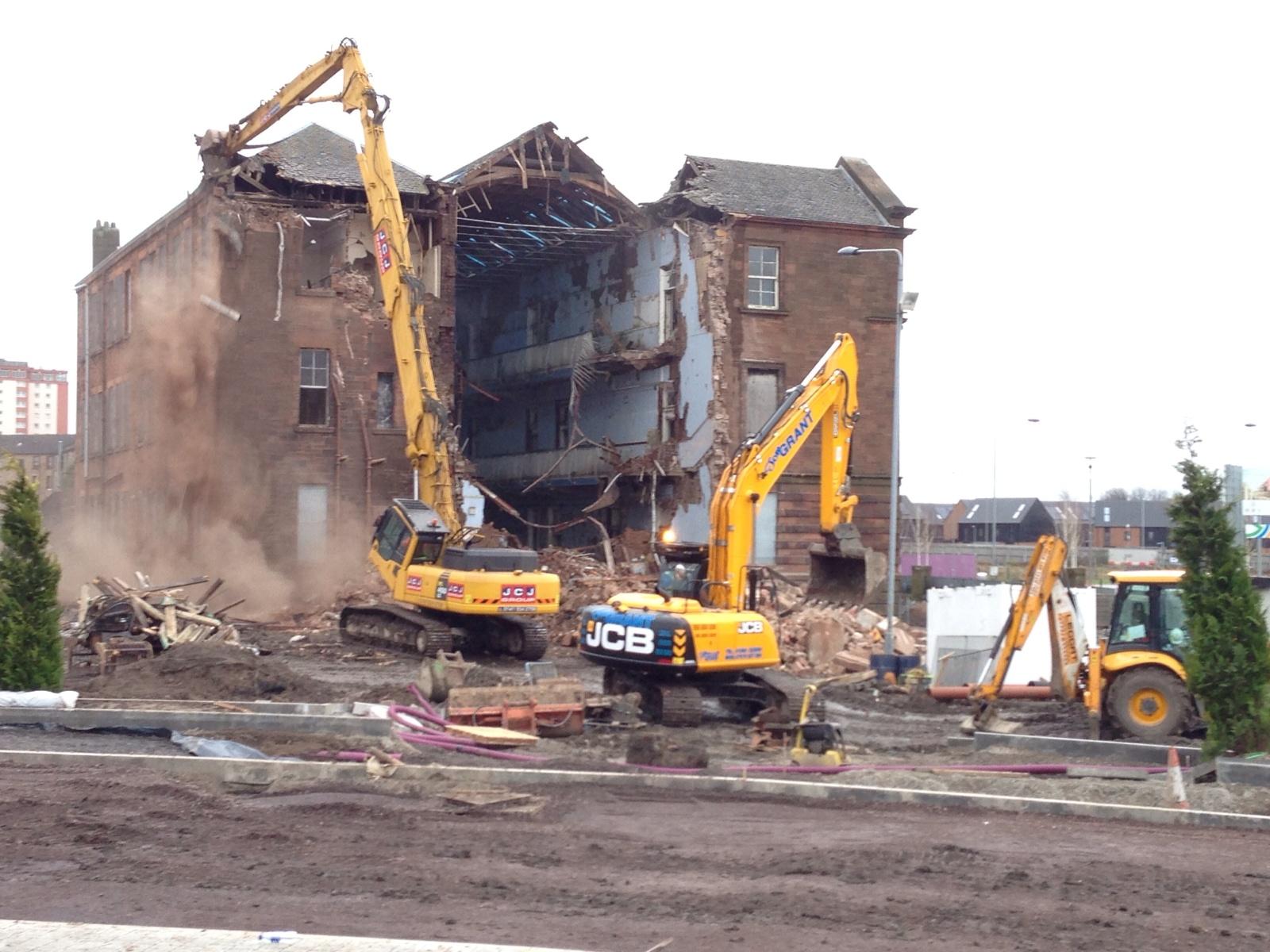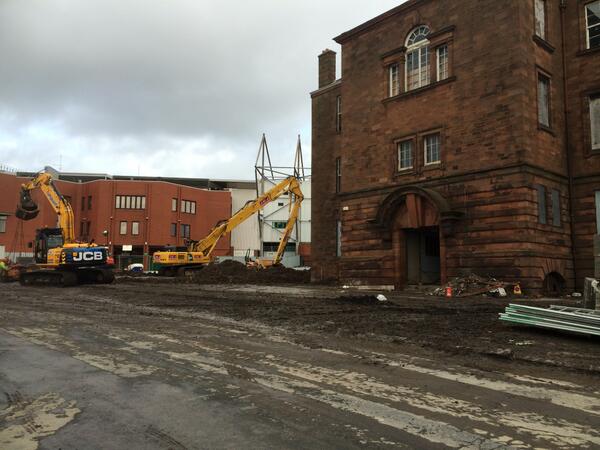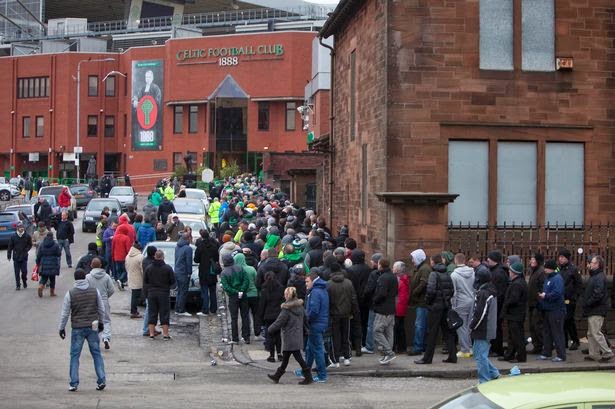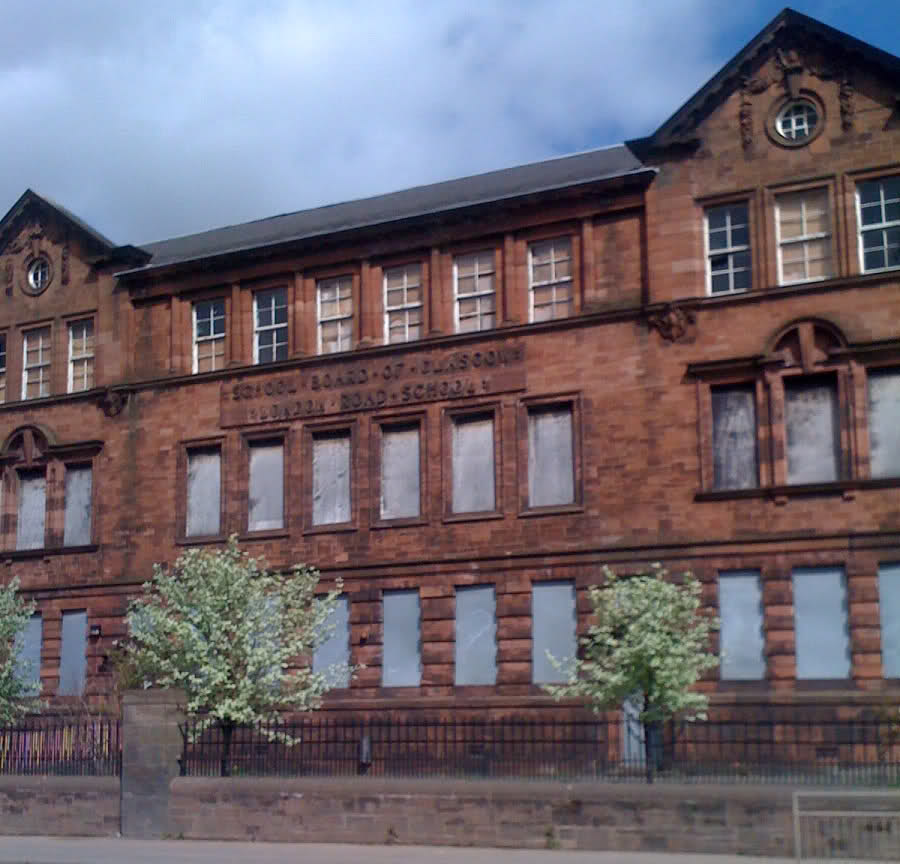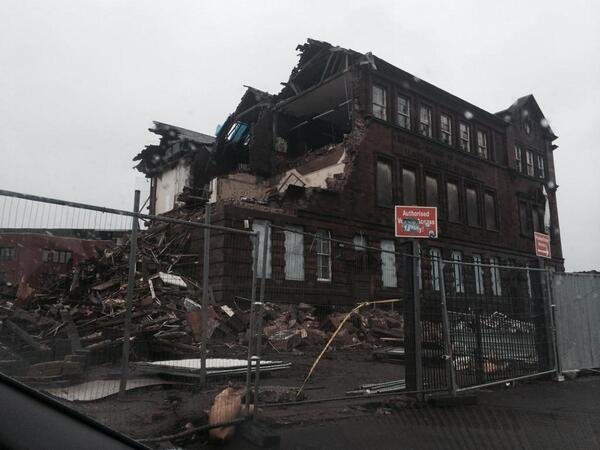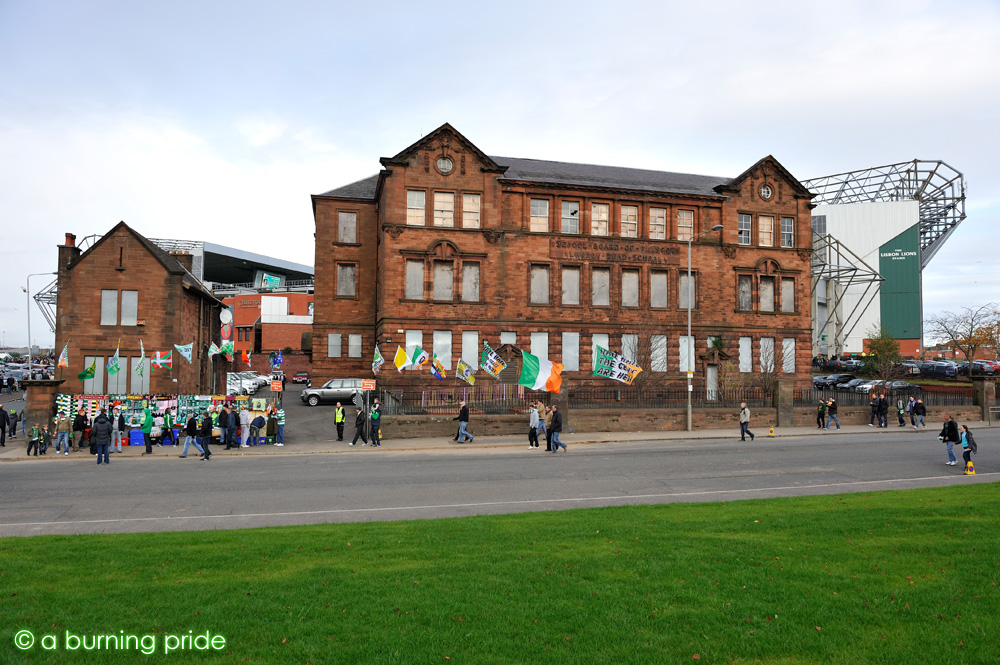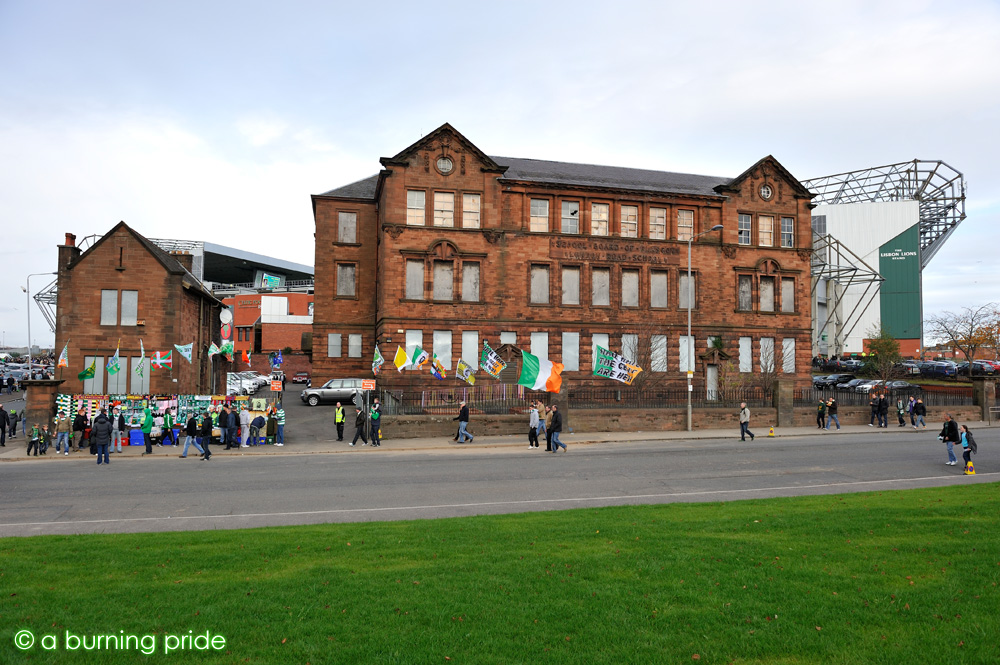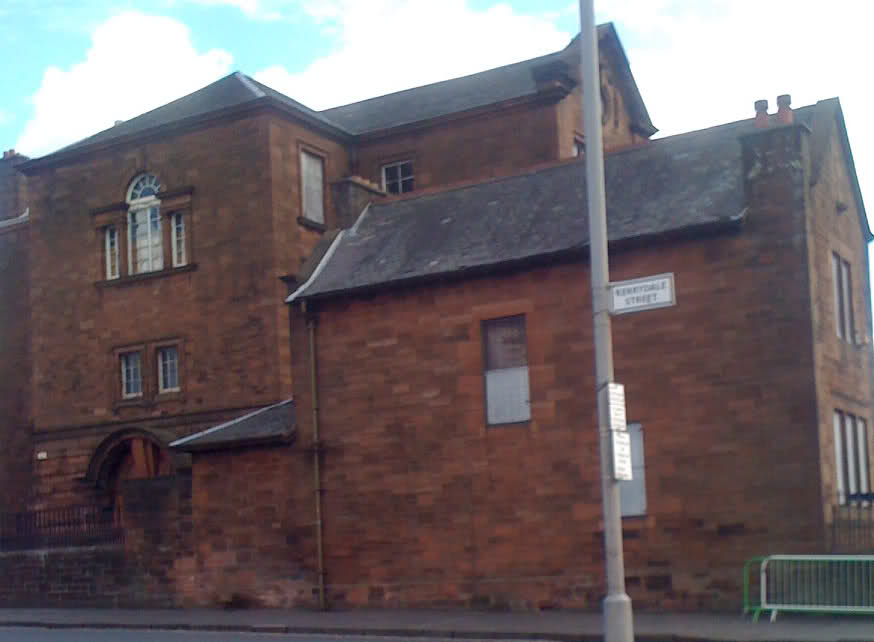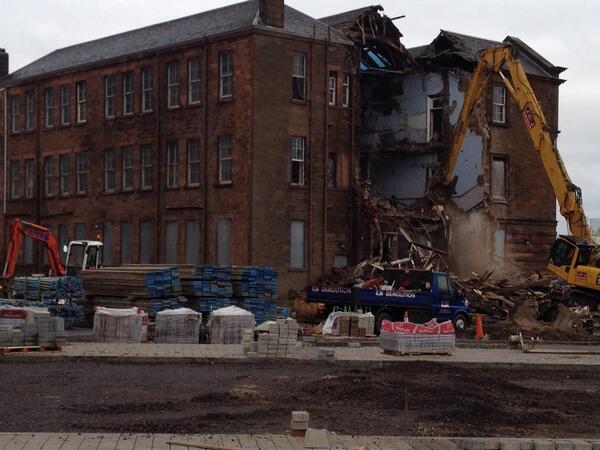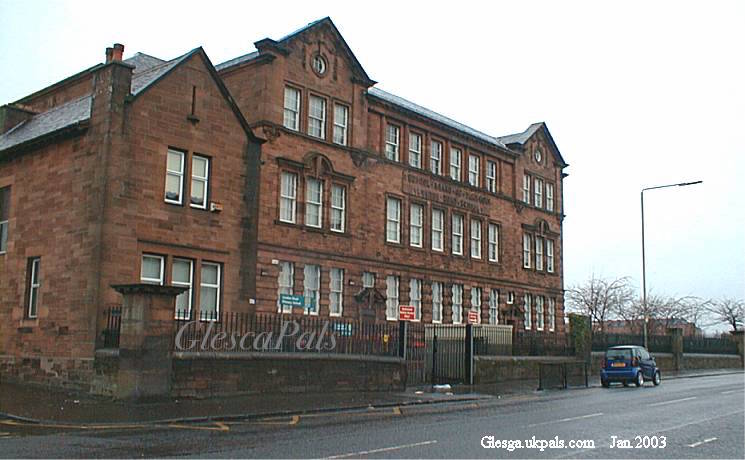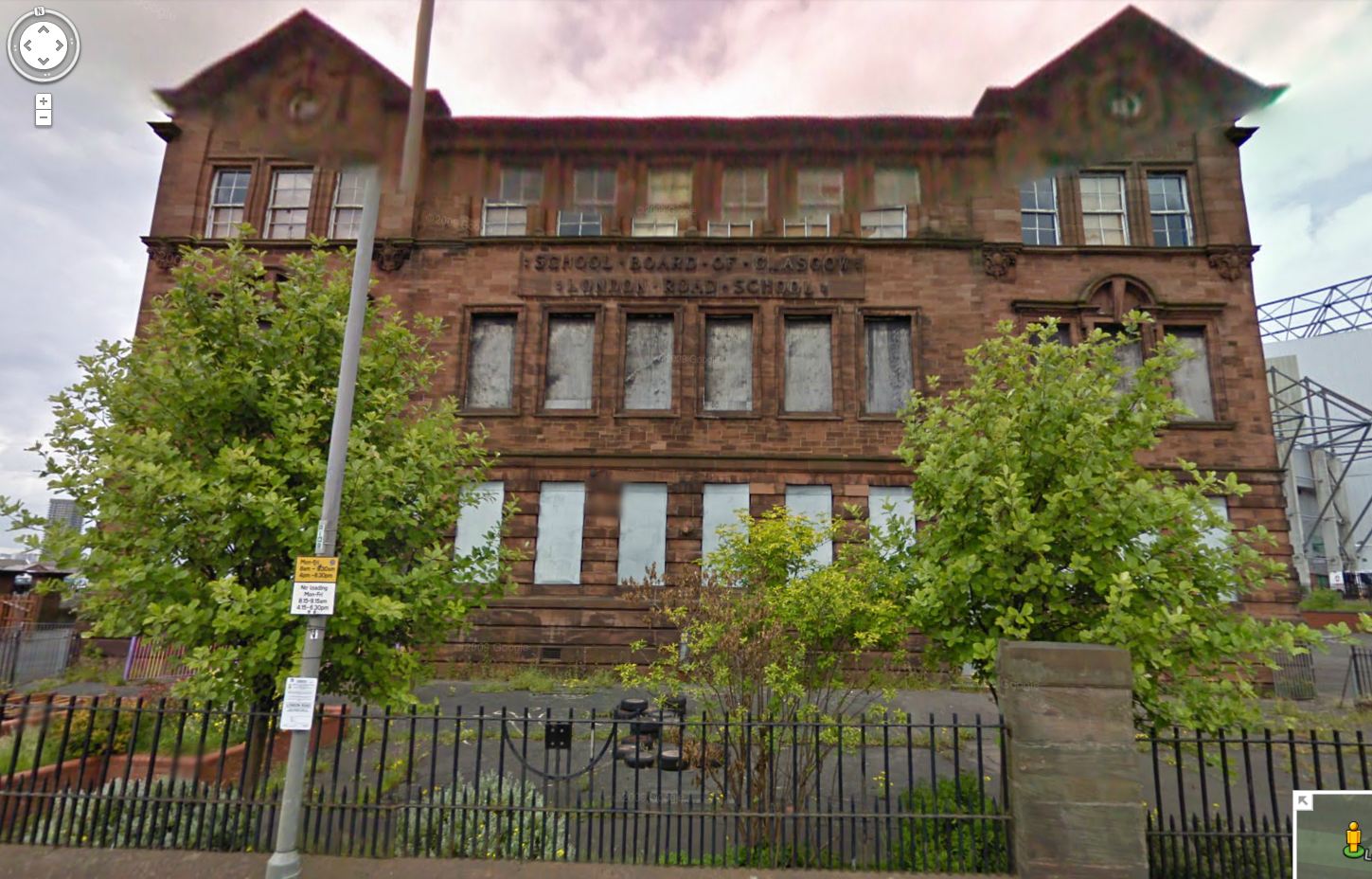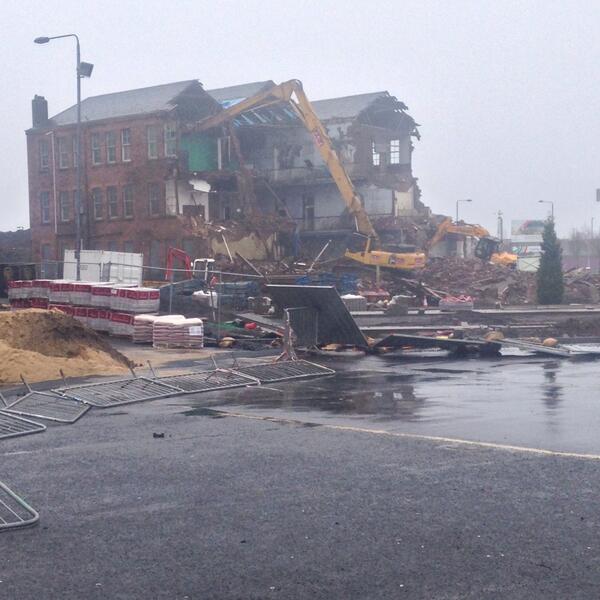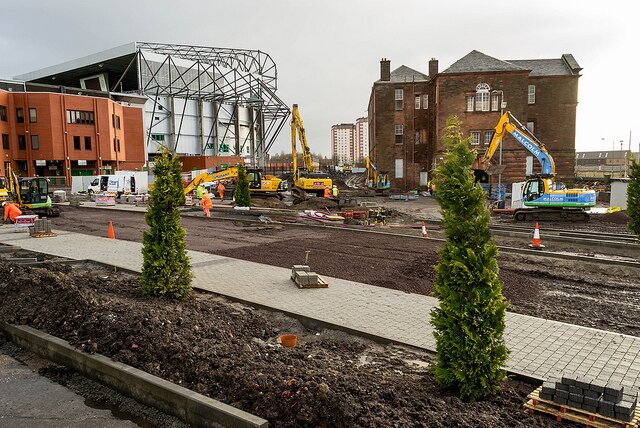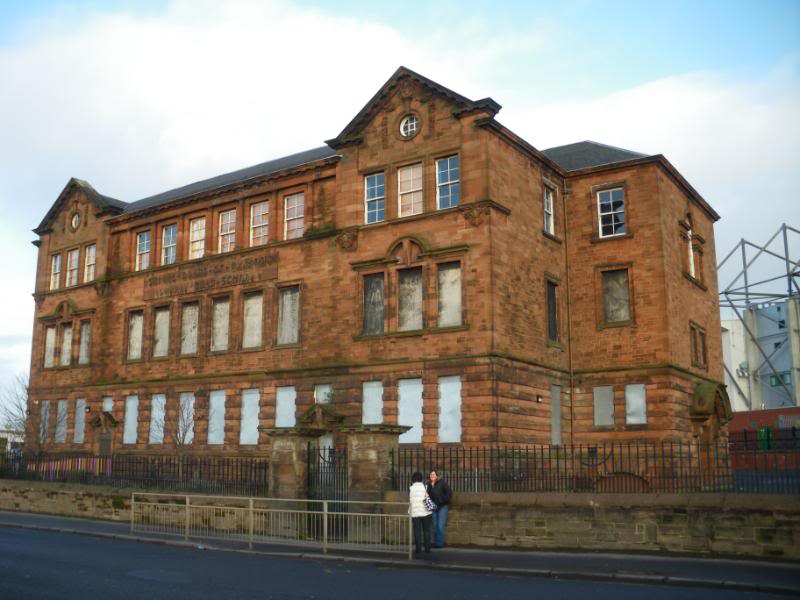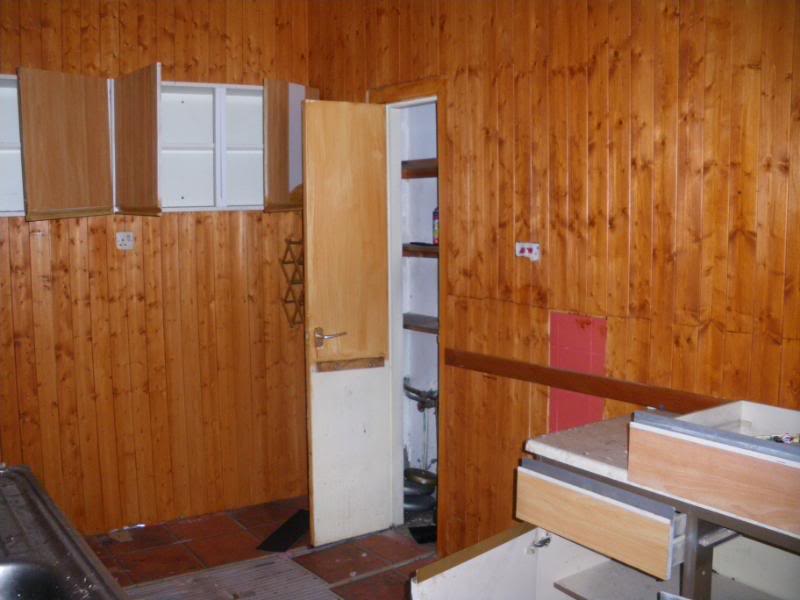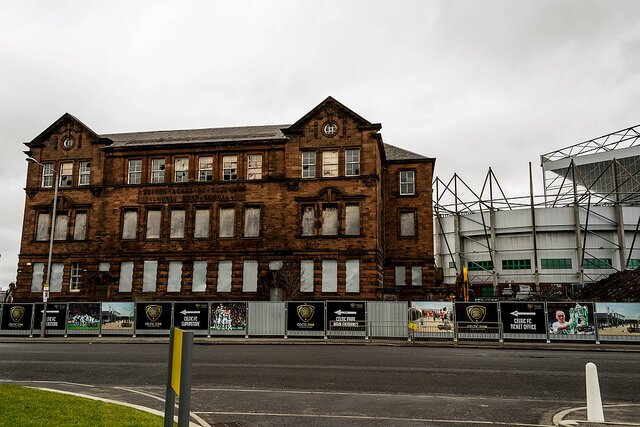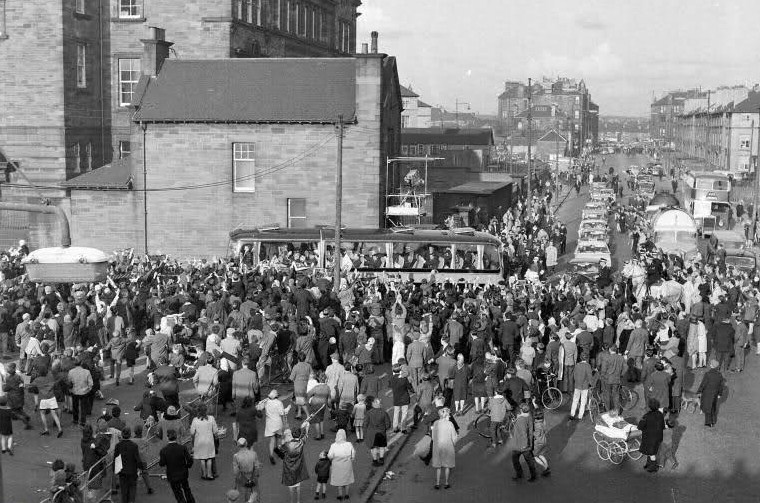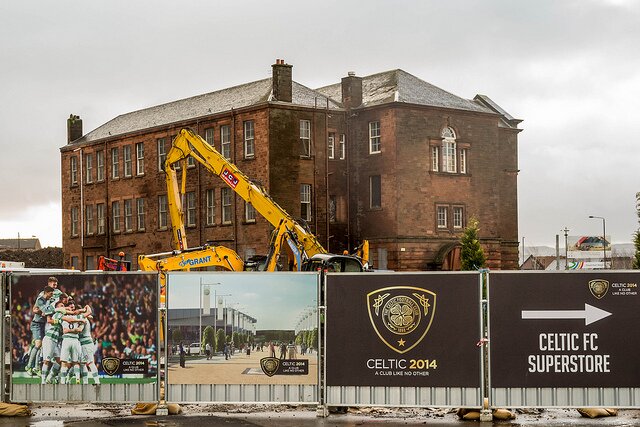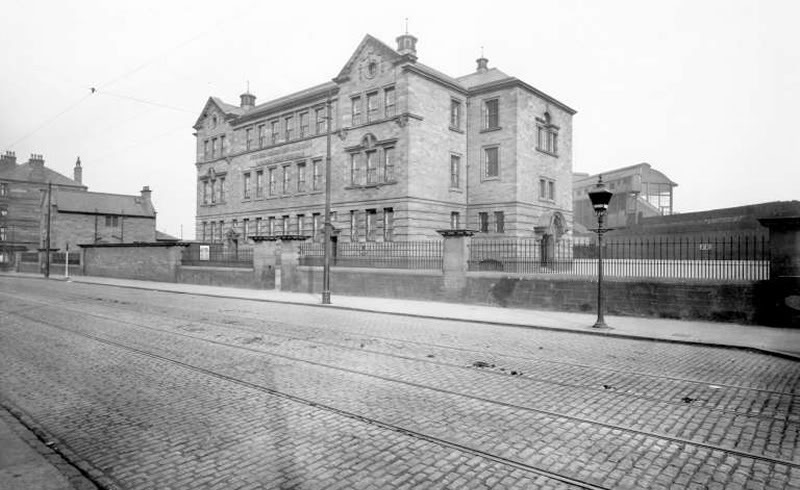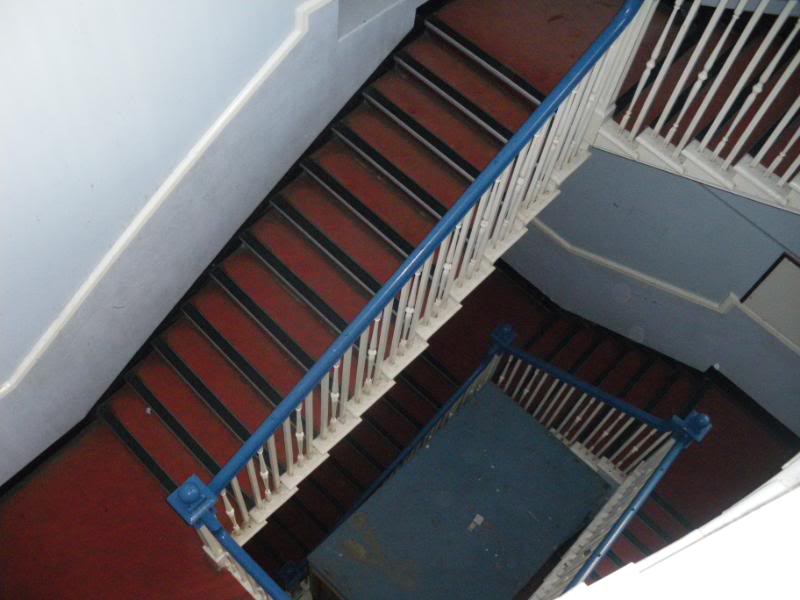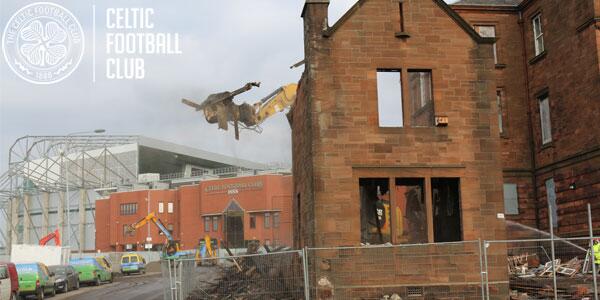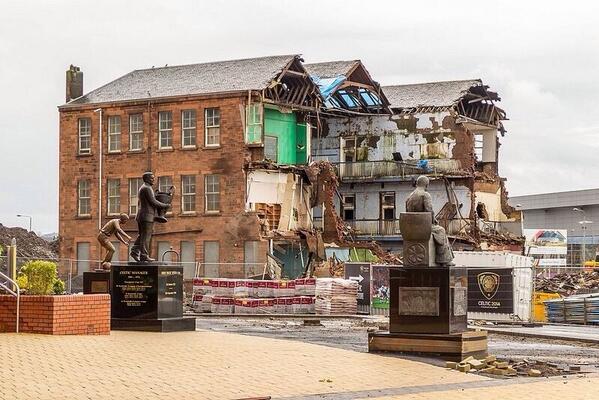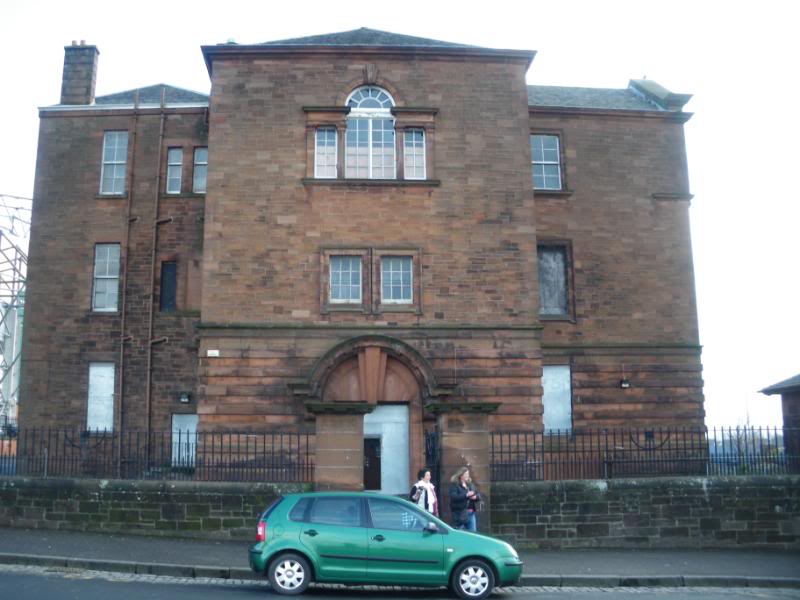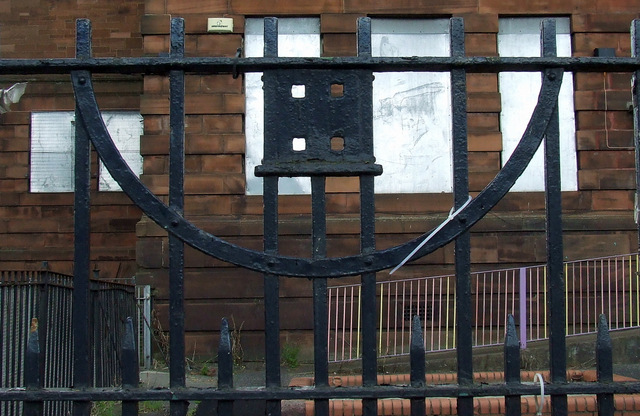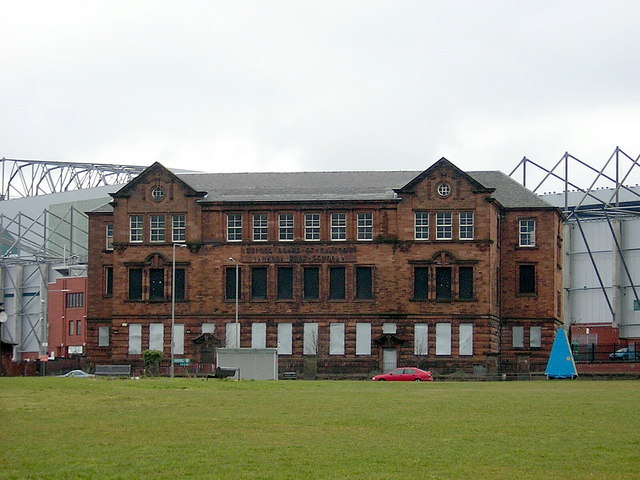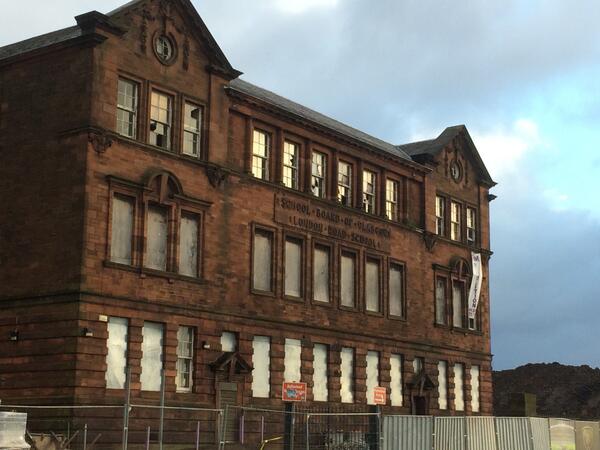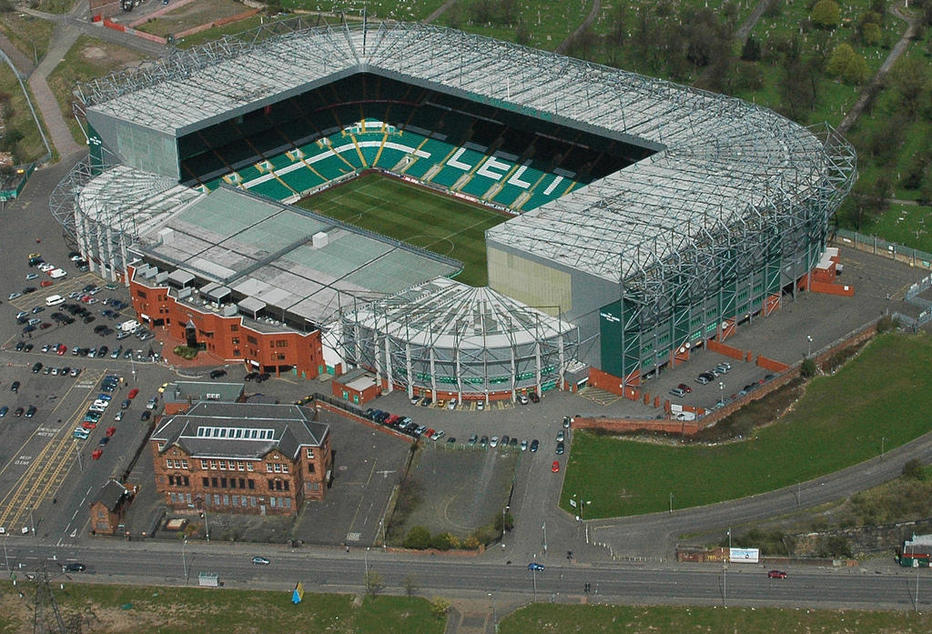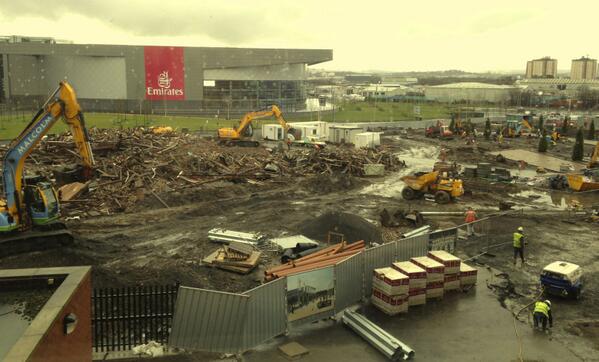Details
Buildings: London Road Primary School & Janitor’s House
Address: 1147 & 1167, London Road, Glasgow, G40 3RF
Built: 1905-1907
School Open-Close: 1907-Mar 2004
Demolished: 30 Jan 2014 (janitors building); 22 Feb 2014 (London Road Primary School)
Landmark buildings at Celtic Park
For all supporters who used to come to Celtic Park, one of the most notable landmarks they came across on their first visit was the old school that was at the foot of Kerrydale Street which all supporters passed on their way to the front end of Celtic Park.
This school & adjacent janitor’s house lay at the junction as you turned into the road to head to the main entrance of Celtic Park. A curious location for a school being at the foot of a major football stadium, but what a great experience for all those school children. The old school was a typical old red brick building in a very old traditional style, a little imposing too.
A story from past pupils from the London Road School revealed that Celtic great Bertie Peacock used to train and take the kids on a Saturday morning; a lot of the older locals around Parkhead still talk about the days when “The Little Ant” was in charge of their school football team. Likely various other players did so too.
On match days the playgrounds were used for car parking, and the front gates and areas around the grounds were prime spots for street-traders of Celtic wares and for Burger Vans too.
A description of the school buildings’ designs can be summarised as follows:
Board school, big Edwardian baroque symmetrical 3-storey red ahslar block with banded rustication at ground, pedimented outer pavilions, close-spaced windows between with colonnade at top floor; stair/entrance bays recessed on flanks; original glazing; slate roofs. Lodge is more simply detailed, narrow, 2 storeys; iron-railed boundary wall, square gatepiers with projecting flat caps.
(Historic Scotland)
A typical turn-of-the century board school (classrooms round a central hall) with a superior English Baroque exterior.
(Williamson, Riches, Higgs)
The buildings were opened in 1907 and the school gates finally closed in March 2004. The buildings were left dormant for many years thereafter, all boarded up and derelict. A sad sight but various overdue plans were presented to regenerate the site, as in their degenerating state they had become an unintended eyesore and sad to see in light of their history. Thieves had even attempted to steel slate off the roofs of the buildings for their own unscrupulous greed.
Celtic won a Planning Application in May 2013 to demolish the former London Road Primary School building beside Celtic Park, agreed at a committee meeting. Part of the plan was to create new “superstore, museum, theatre, café, ticket sales, offices and associated facilities”. Plans also included that Celtic would create an “Avenue of Heroes” stretching from London Road to the front door of stadium, which would include “sculptures of famous club figures incorporated into the landscape strategy“. A welcome move for Celtic to purchase the site for £300k and redevelop the area, with the demolition of the building to see material reused where possible and sections retained if possible.
The building was marked for demolition on 13 Nov 2013. The janitor’s house was demolished on 30 Jan 2014, and the school itself on 22 Feb 2014.
The club was losing local old landmarks that was for sure, but in their place a grand museum, an “Avenue of Heroes” [later re-titled “The Celtic Way“] and other services would be a decent replacement, and this would give the stadium a wonderful new walkway befitting to the local community and the ground.
Below shows on the LHS the Janitor’s House, and on the RHS the school…
Lollipop man Alan McTear who helped kids to the school back in the day,
see: http://www.glesga.ukpals.com/schools/londonrdmain.htm
The School & Janitor’s house as it sat at the foot of Celtic Park until it’s demolition
Image of Celtic Park post-demolition (photoshop job)
Links
Key meeting to decide future of school outside Celtic stadium
Gerry Braiden
Senior reporter
Saturday 4 May 2013
PLANS to demolish the B-listed school outside Celtic’s stadium and replace it with a superstore, museum, theatre, cafe and ticket offices have been earmarked to go ahead.
Glasgow City Council will meet next week to discuss Celtic’s bid to knock down the Edwardian London Road Primary School as part of their plan to regenerate the area in time for the Commonwealth Games.
Officials at the authority have recommended that the club’s proposals, which involve the sale of the school by the council to Celtic for around £300,000, are approved.
But heritage chiefs could yet stall the bid. Historic Scotland, which the council is legally required to consult with, claims the application for demolition does not comply with Government policies, and questions whether the council is satisfied enough was done to market the building and assess all options. It says the structural report does not support the case for demolition.
Most damage to the school, which shut after 97 years in 2004 and has lain derelict since, has followed the theft of materials from the roof.
The proposals also include the formation of a landscaped avenue, essentially a wide walkway from a revamped Dalmarnock railway station, past several key 2014 venues and reaching Celtic Park. The avenue would be paved with inscribed stones paid for by fans. The new National Indoor Sports Arena and Velodrome facing Celtic Park have been completed in the past few months, while a new four-lane, 1.6-mile carriageway linking the M74 extension to the East End, skirting the stadium, has opened to traffic.
Celtic Park is hosting the 2014 Games opening ceremony, which will be attended by the Queen.
Supporting the case for pulling down the building and replacing it with the new complex, Celtic said the school offered “no particular architectural or historic interest or importance” and that given its prominent location, “without the prospect of conversion and physical improvement it will seriously detract from the image of Glasgow and is likely to deter further investment in the surrounding area and the remainder of the city”.
The council said the city still retains “many good examples of municipal school architecture” and that in terms of overall costs, “it might be the case that demolition and new build is more viable than the reuse of the existing building”.
The club submitted a master-plan three years ago with a view to enhancing the area around the ground.
A Celtic spokesman said: “This is the club playing its part in the major regeneration of the East End of Glasgow. It’s a particularly vibrant time for the area and this is an overwhelmingly positive project.”
Celtic given permission to demolish school and build club museum
STV 7 May 2013 16:12 BST
Interior shot of Celtic Park. Celtic: The club received planning permission for the demolition move.SNS Group
Celtic has been given planning permission to demolish a listed school building to make way for a museum and superstore.
The Parkhead club was given permission for the move by Glasgow City Council’s planning applications committee on Tuesday.
Under the proposals, Celtic will demolish B-listed London Road Primary School, which has been out of use since it closed in March 2004.
In its place, the Glasgow club plans to create a new building, which will include an official superstore, museum, theatre, cafe, ticket sales, offices and associated facilities.
The plans also includes Celtic would form a new “Avenue of Heroes” stretching from London Road to the front door of the club’s stadium, which would include “sculptures of famous club figures incorporated into the landscape strategy.”
In a statement on is official website on Tuesday, the club said it hopes to have these public realms works completed in time for the 2014 Commonwealth Games, which will open at a ceremony at Celtic Park.
Celtic chief executive Peter Lawwell welcomed the decision. He said: “This really is fantastic news for the club and is something which will allow us to completely transform Celtic Park, providing a stunning new public realm area for the benefit of our supporters.
“For so many years Celtic has been a fundamental part of the east end of Glasgow – this development represents real positive regeneration of the east end, something to which we are totally committed.The club is in great shape on and off the field and today’s news allows us to build on these strong foundations and take the club forward once again.
“We have enjoyed a fantastic 125th anniversary season, delivering success to our fans and making a real impression across European football.
“Today’s announcement lets us build on this great season. It means we can look ahead to more exciting times for Celtic and our supporters as we continue to progress the club in the right direction and show that Celtic continues to be one of the world’s leading football clubs.”
According to a report before the committee, the council’s executive director of development and regeneration services Richard Brown recommended that it was granted subject to conditions, including that car and cycle parking spaces are provided.
Mr Brown stated in the report: “The redevelopment of this site for a modern purpose built development, which offers a range of facilities to visitors to Celtic Football Club and this area together with its associated public realm works, is considered a positive outcome.
“The proposed development is also considered to respond to the developing local context, which has undergone major redevelopment over the last few years, further supporting the regeneration of the area and ensuring that members of the public and local community continue to visit and get involved with activities in the local area.”
Five representations raising objections to the plan had been received by the council, including claims that the school building is of “significant importance and removal would have a negative impact” on the area, the proposal is “inappropriate”, the school building “should be retained” and the ground in question is not owned by Celtic.
However, the council found that the demolition – which will now be considered by Historic Scotland – was acceptable as it “would support the ongoing regeneration of the area”, even though it did not consider the building to be beyond saving. While it also supported the proposal in its capacity as landowner of the London Road site.














